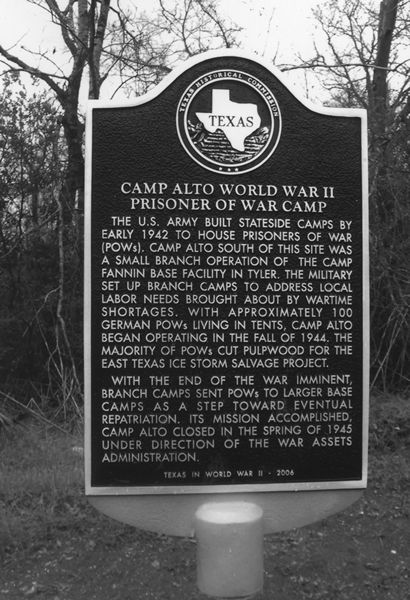German POW camps in East Texas. (original) (raw)
In the 1940s East Texas sawmills and paper mills lost many of their loggers to the armed forces fighting during World War II.
The problem was solved with a unique exchange.
German soldiers who had been captured in Europe were brought to the U.S. and conscripted as loggers.
Today, the unusual trade is remembered by seven Texas historical markers placed near German POW camps at Alto, Center, Chireno, Huntsville, Lufkin, San Augustine and Tyler.

A Texas State Historical marks the site of Camp Alto, one of seven German prisoner-of-war camps in East Texas during World War II
The Germans came to East Texas through the efforts of companies like Southern Pine Lumber Company of Diboll, Frost Lumber Company of Nacogdoches, and Angelina County Lumber Company of Keltys, near Lufkin.
History, regrettably, doesn�t record many of the names of the German soldiers who came to East Texas, but most of them worked hard in the woods, felling trees, cutting them into pulpwood or lumber logs and shipping them on railcars bound for the sawmills.
Some Germans, however, deliberately slowed down their work, believing that shortages of lumber would hurt the American war effort.
While East Texans struggled with the notion that the German POWs would escape and commit all kinds of atrocities to their families, there were few such events. The Germans simply did their jobs and most were returned to Germany after the war. Some remained in East Texas; one even became the president of the chamber of commerce at San Augustine.
A few of the Germans escaped, but became lost and eventually wandered back to their logging camps.
When a prisoner escaped at the Chireno camp, guards found him in a cow pasture holding a little girl, and the mother was deeply upset. The guards discovered, however, that the girl had wandered into the pasture, where there were some bulls.
The escapee scooped up the child and when the guards raced toward the POW, he and the little girl were talking to nearby cows. The little girl told the guards. �He nice man. He show me cows.�
| Author Mark Choate chronicled the story of the Germans in his excellent 1989 book, �Nazis in the Pineywoods.� Except for the historical markers, little remains of the old POW camps. In Lufkin, a stone gate bears an inscription scratched into the stone: �Rothhammer, 1944,� a reminder of a German POW who lived there. Bob Bowman's East TexasFebruary 2, 2009 Column. A weekly column syndicated in 70 East Texas newspapers | | | ------------------------------------------------------------------------------------------------------------------------------------------------------------------------------------------------------------------------------------------------------------------------------------------------------------------------------------------------------------------------------------------------------------------------------------------------------------------------------------------------------- | |
**Forum:**Subject: Mistake in Bob Bowman's otherwise excellent column
Mr. Bowman repeats misinformation about Nazi POWs who stayed behind in San Augustine. He writes that an anomymous POW stayed behind (which wasn't allowed), married a local gal, and became the SA Chamber of Commerce President and then a state rep. This article on the Hemphill Daily News web site offers a different set of information. A U.S. Army sgt named George Goetz came to SA to work as a translator. When the camp closed, he stayed behind and married a local girl. Thanks for your attention. - Roy Bragg, March 16, 2023